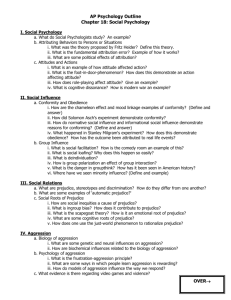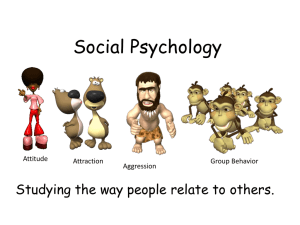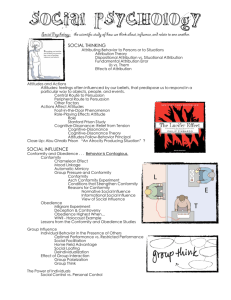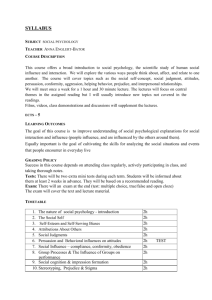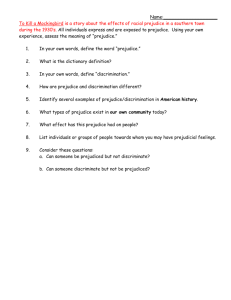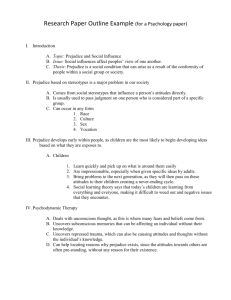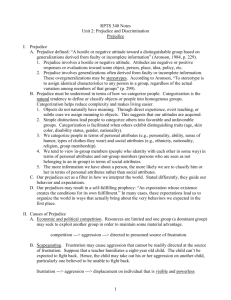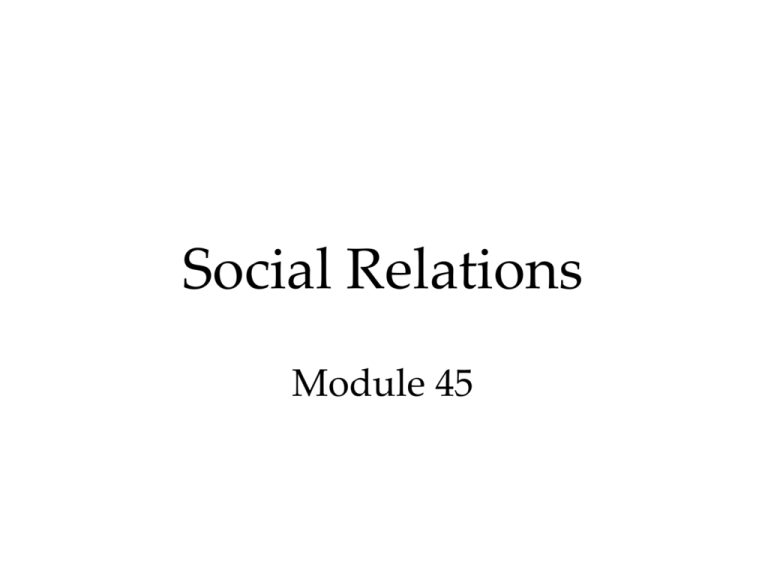
Social Relations
Module 45
Social Psychology
Social Relations
Prejudice
Aggression
Attraction
Altruism
Conflict and Peacemaking
Social Relations
Social psychology teaches us how we relate to
one another through prejudice, aggression, and
conflict to attraction, and altruism and
peacemaking.
Prejudice
Simply called “prejudgment,” a prejudice is an
unjustifiable (usually negative) attitude toward
a group and its members. Prejudice is often
directed towards different cultural, ethnic, or
gender groups.
Components of Prejudice
1. Beliefs (stereotypes)
2. Emotions (hostility, envy, fear)
3. Predisposition to act (to discriminate)
Reign of Prejudice
Prejudice works at the conscious and [more at]
the unconscious level. Therefore, prejudice is
more like a knee-jerk response than a conscious
decision.
How Prejudiced are People?
Over the duration of time many prejudices
against interracial marriage, gender,
homosexuality, and minorities have decreased.
Racial & Gender Prejudice
Americans today express much less racial and
gender prejudice, but prejudices still exist.
Race
Nine out of ten white respondents were slow
when responding to words like “peace” or
“paradise” when they saw a black individual’s
photo compared to a white individual’s photo
(Hugenberg & Bodenhausen, 2003).
Gender
Most women still live in more poverty than
men. About 100,000,000 women are missing in
the world. There is a preference for male
children in China and India, even with sexselected abortion outlawed.
Gender
Although prejudice prevails against women, more people
feel positively toward women than men. Women rated
picture b [feminized] higher (66%) for a matrimonial ad
(Perrett & others, 1998).
Professor Dave Perrett, St. Andrews University
Social Roots of Prejudice
Why does prejudice arise?
1. Social Inequalities
2. Social Divisions
3. Emotional Scapegoating
Social Inequality
Prejudice develops when people have money,
power, and prestige, and others do not. Social
inequality increases prejudice.
Us and Them
Ingroup: People with whom one shares a
common identity. Outgroup: Those perceived as
different from one’s ingroup. Ingroup Bias: The
tendency to favor one’s own group.
Mike Hewitt/ Getty Images
Scotland’s famed “Tartan Army” fans.
Emotional Roots of Prejudice
Prejudice provides an outlet for anger [emotion]
by providing someone to blame. After 9/11
many people lashed out against innocent
Arab-Americans.
Cognitive Roots of Prejudice
One way we simplify our world is to categorize.
We categorize people into groups by
stereotyping them.
Michael S. Yamashita/ Woodfin Camp Associates
Foreign sunbathers may think Balinese look alike.
Cognitive Roots of Prejudice
In vivid cases such as the 9/11 attacks, terrorists
can feed stereotypes or prejudices (terrorism).
Most terrorists are non-Muslims.
Cognitive Roots of Prejudice
© The New Yorker Collection, 1981, Robert Mankoff from cartoonbank.com. All Rights Reserved.
The tendency of people to believe the world is
just, and people get what they deserve and
deserve what they get (the just-world
phenomenon).
Hindsight Bias
After learning an outcome, the tendency to
believe that we could have predicted it
beforehand may contribute to blaming the
victim and forming a prejudice against them.
Aggression
Aggression can be any physical or verbal
behavior intended to hurt or destroy.
It may be done reactively out of hostility or
proactively as a calculated means to an end.
Research shows that aggressive behavior emerges
from the interaction of biology and experience.
The Biology of Aggression
Three biological influences on aggressive
behavior are:
1. Genetic Influences
2. Neural Influences
3. Biochemical Influences
Influences
Genetic Influences: Animals have been bred for
aggressiveness for sport and at times for research.
Twin studies show aggression may be genetic. In
men, aggression is possibly linked to the Y
chromosome.
Neural Influences: Some centers in the brain,
especially the limbic system (amygdala) and the
frontal lobe, are intimately involved with
aggression.
Influences
Biochemical Influences: Animals with diminished
amounts of testosterone (castration) become docile,
and if injected with testosterone aggression
increases. Prenatal exposure to testosterone also
increases aggression in female hyenas.
The Psychology of Aggression
Four psychological factors that influence
aggressive behavior are:
1.
2.
3.
4.
dealing with aversive events;
learning aggression is rewarding;
observing models of aggression; and
acquiring social scripts.
Aversive Events
Studies in which animals and humans experience
unpleasant events reveal that those made
miserable often make others miserable.
Jeff Kowalsky/ EPA/ Landov
Ron Artest (Pacers) attack on Detroit Pistons fans.
Environment
Even environmental temperature can lead to
aggressive acts. Murders and rapes increased
with the temperature in Houston.
Frustration-Aggression Principle
A principle in which frustration (caused by the
blocking of an attempt to achieve a desired goal)
creates anger, which can generate aggression.
Learning that Aggression is
Rewarding
When aggression leads to desired outcomes, one
learns to be aggressive. This is shown in both
animals and humans.
Cultures that favor violence breed violence.
Scotch-Irish settlers in the South had more violent
tendencies than their Puritan, Quaker, & Dutch
counterparts in the Northeast of the US.
Observing Models of Aggression
Sexually coercive men
are promiscuous and
hostile in their
relationships with
women. This
coerciveness has
increased due to
television viewing of Rand X-rated movies.
Acquiring Social Scripts
The media portrays social scripts and generates
mental tapes in the minds of the viewers. When
confronted with new situations individuals may
rely on such social scripts. If social scripts are
violent in nature, people may act them out.
Do Video Games Teach or Release
Violence?
The general consensus on violent video games
is that, to some extent, they breed violence.
Adolescents view the world as hostile when
they get into arguments and receive bad grades
after playing such games.
Summary
The Psychology of Attraction
1. Proximity: Geographic nearness is a powerful
predictor of friendship. Repeated exposure to
novel stimuli increases their attraction (mere
exposure effect).
Rex USA
A rare white penguin born
in a zoo was accepted after
3 weeks by other penguins
just due to proximity.
Psychology of Attraction
2. Physical Attractiveness: Once proximity
affords contact, the next most important thing
in attraction is physical appearance.
Brooks Kraft/ Corbis
Brooks Kraft/ Corbis
Psychology of Attraction
3. Similarity: Similar views among individuals
causes the bond of attraction to strengthen.
Similarity breeds content!
Romantic Love
Passionate Love: An aroused state of intense
positive absorption in another, usually present at
the beginning of a love relationship.
Two-factor theory of emotion
1. Physical arousal plus cognitive appraisal
2. Arousal from any source can enhance one
emotion depending upon what we interpret or
label the arousal
Romantic Love
Companionate Love: A deep, affectionate
attachment we feel for those with whom our lives
are intertwined.
Courtship and Matrimony (from the collection of Werner Nekes)
Altruism
An unselfish regard for the welfare of others.
Equity: A condition in which people
receive from a relationship in proportion
to what they give.
Self-Disclosure: Revealing intimate
aspects of oneself to others.
Bystander Intervention
The decision-making process for bystander
intervention.
Akos Szilvasi/ Stock, Boston
Bystander Effect
Tendency of any given
bystander to be less
likely to give aid if other
bystanders are present.
Conflict
Conflict is perceived as an incompatibility of
actions, goals, or ideas.
The elements of conflict are the same at all levels.
People become deeply involved in potentially
destructive social processes that have undesirable
effects.
Enemy Perceptions
People in conflict form diabolical images of one
another.
http://www.aftonbladet.se
http://www.cnn.com
Saddam Hussein
“Wicked Pharaoh”
George Bush
“Evil”
Cooperation
Superordinate Goals are shared goals that
override differences among people and require
their cooperation.
Syracuse Newspapers/ The Image Works
Communication and understanding developed
through talking to one another. Sometimes it is
mediated by a third party.
Communication
Graduated & Reciprocated Initiatives in
Tension-Reduction (GRIT): This is a strategy
designed to decrease international tensions.
One side recognizes mutual interests and
initiates a small conciliatory act that opens the
door for reciprocation by the other party.

